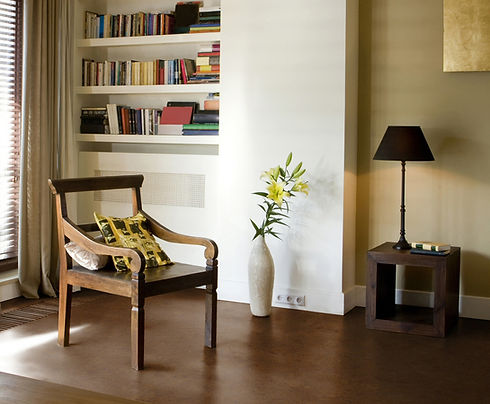Ideal for Most Rooms
Cork is a sustainable and renewable natural energy resource, and is considered one of the most environmentally friendly types of flooring today. The impact of using cork flooring on the environment is low due to the fact that nearly zero waste is produced during the manufacturing process.


Advantages of Cork
01.
Cork for healthy living
02.
Waterproof when coated
03.
Maximum noise reduction
04.
Natural insulator
05.
Allergy resistant
06.
Ideal for most rooms
07.
Many colours & patterns
08.
Easy to clean and maintain

Properties of Cork
Cork, as a natural product, warms and enriches any interior.
With over 40 million “cushion cells” per cubic centimeter, cork is a
natural sound and thermal insulator. Cork floors are beautifully quiet and comfortable underfoot, warm and pleasant to the touch.
Cork cushion cells are tiny, air-filled cells that make up the structure of cork. These cells are highly elastic and provide cork with its unique properties, such as cushioning, flexibility, and the ability to compress and return to their original shape. The air within these cells gives cork its lightweight and shock-absorbing qualities, making it ideal for applications like flooring, insulation, and padding.
Cork trees are remarkable too because they can be harvested for their bark without causing harm to the tree. The outer bark of the cork tree is carefully stripped every 9 to 12 years, a process called "corking." Only the outer bark is removed, and the tree itself remains intact and healthy. After the bark is harvested, the tree continues to grow new cork bark. The cork grows back thicker and more uniform with each harvest cycle, improving in quality over time. The tree can live for hundreds of years, and each tree can be harvested multiple times. The cork bark is essential for protecting the tree from harsh weather conditions, pests, and diseases. As the tree matures, the quality of the cork improves, making it highly valuable for various uses.
In summary, cork trees thrive after being harvested, and the process is sustainable, making cork a renewable resource. The cork industry helps preserve cork forests, as the trees need to be kept healthy for continuous harvesting, providing a natural habitat for wildlife as well.
How to care for your cork
-
After the final coat of polyurethane has been applied, wait at least 24 hours before walking on the floor, only with socks or soft shoes – i.e. light traffic.
-
Do not shift furniture onto the newly installed floor until at least 72 hours have elapsed and make sure all furniture legs have protective pads underneath. Pay particular attention to stools that have metal legs as these can have the same effect as walking on the floor with stiletto heels, i.e. marking, denting. Never drag furniture or appliances across a cork floor.
-
To keep your cork floor clean, use either our Finacare product, specially formulated to clean cork floors, or use just a few drops of dishwashing detergent in warm water. Do not use excess water, just a damp application.
-
Never use a steam mop or commercial/abrasive floor cleaners, as these can scratch the surface.
-
Always use a mat outside the entry door, and possibly inside, as this will remove grit, stones and dirt from shoes, which can also damage the floor.


